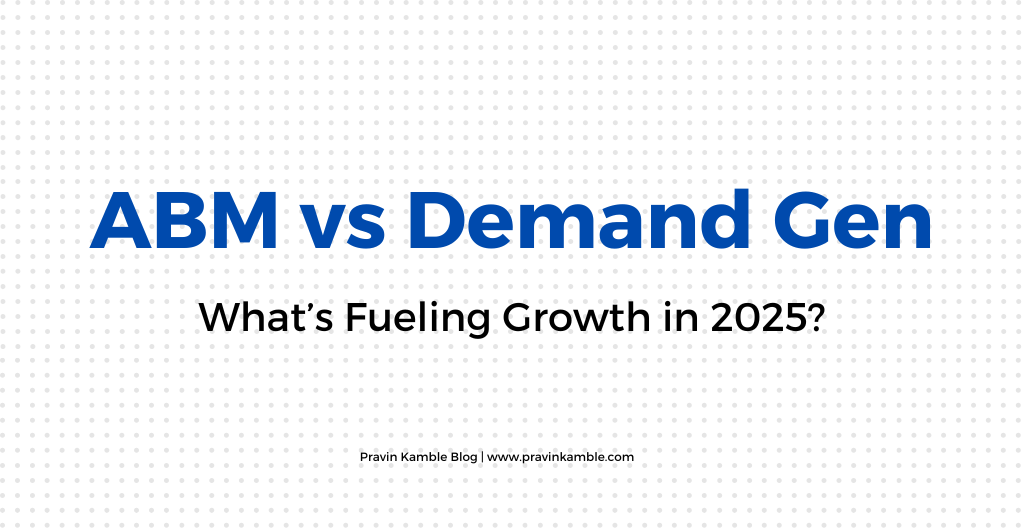Introduction: Why This Debate Matters More Than Ever
In today’s complex B2B landscape, the tension between Account-Based Marketing (ABM) and Demand Generation (Demand Gen) is more relevant than ever. As buyer journeys grow longer and decision-making units expand, marketers face mounting pressure to justify spend and deliver pipeline. But should you invest in ABM, scale Demand Gen, or blend both? This article unpacks the core differences, overlaps, and strategic applications of each approach.
1. Definitions: What Are We Really Talking About?
ABM is a strategic approach that treats individual accounts as markets in their own right. It emphasizes high personalization, long sales cycles, and close alignment with sales teams.
Demand Gen, on the other hand, focuses on driving awareness and inbound interest at scale. It leverages content, SEO, paid media, and marketing automation to attract leads that fit an ideal customer profile.
While ABM is hyper-targeted and sales-centric, Demand Gen casts a wider net to fill the top of the funnel.
2. Targeting: Precision vs. Scale
ABM zeroes in on specific, high-value accounts—often with named contacts—offering personalized content and engagement.
Demand Gen prioritizes broader audience segments and buyer personas. It excels at reaching a large pool of potential prospects but risks attracting lower-quality leads.
The key distinction? ABM is about quality, while Demand Gen emphasizes quantity.
3. Funnel Focus: Top vs. Bottom
Demand Gen shines at top-of-funnel (TOFU) lead attraction through webinars, whitepapers, and social campaigns.
ABM thrives at bottom-of-funnel (BOFU), where one-to-one interactions, tailored demos, and executive alignment drive deals forward.
Each approach dominates different stages of the funnel—which is why many successful B2B teams blend them.
4. Metrics That Matter
ABM Metrics:
- Account engagement score
- Pipeline velocity
- Deal size and win rate
Demand Gen Metrics:
- Marketing Qualified Leads (MQLs)
- Cost per Lead (CPL)
- Conversion rate and CAC (Customer Acquisition Cost)
The measurement systems differ, but both aim to influence revenue. Knowing what to track based on your strategy is key.
5. Tech Stacks: Tools That Power Both
ABM tools include:
- 6sense for predictive targeting
- Terminus for personalized display ads
- Demandbase for account insights
Demand Gen tools include:
- HubSpot for automation
- Google Ads and LinkedIn Ads for paid campaigns
- SEMrush and Ahrefs for SEO-driven content
Interestingly, many platforms are now offering features that support both approaches.
6. Hybrid Models: Why You Don’t Need to Choose
Modern B2B marketing isn’t about choosing one strategy over the other. A hybrid model leverages Demand Gen to create awareness and ABM to accelerate key accounts.
For instance, a SaaS company might run LinkedIn campaigns to generate leads, then nurture key decision-makers from priority accounts with ABM-style personalization.
7. Decision Framework: Which One Is Right for You?
Ask yourself:
- Are you targeting a broad market or a niche audience?
- Do you sell high-ticket items with long sales cycles?
- Is your sales team involved early or later in the funnel?
Use this simple matrix:
| Factor | ABM | Demand Gen |
|---|---|---|
| Deal Size | High | Low to Medium |
| Sales Cycle | Long | Short to Medium |
| Audience Size | Small/Niche | Broad |
| Personalization Level | High | Moderate |
Conclusion: ABM vs Demand Gen Is Not a Battle—It’s a Balance
B2B marketers don’t have to choose sides. The smartest strategy is often a fusion: generate scalable demand while closing high-value accounts with precision. In 2025, the real power lies in orchestrating both efforts into one revenue-driven engine.
If you’re navigating this decision and building your 2025 marketing playbook, this is your moment to rethink how these strategies can work together.

